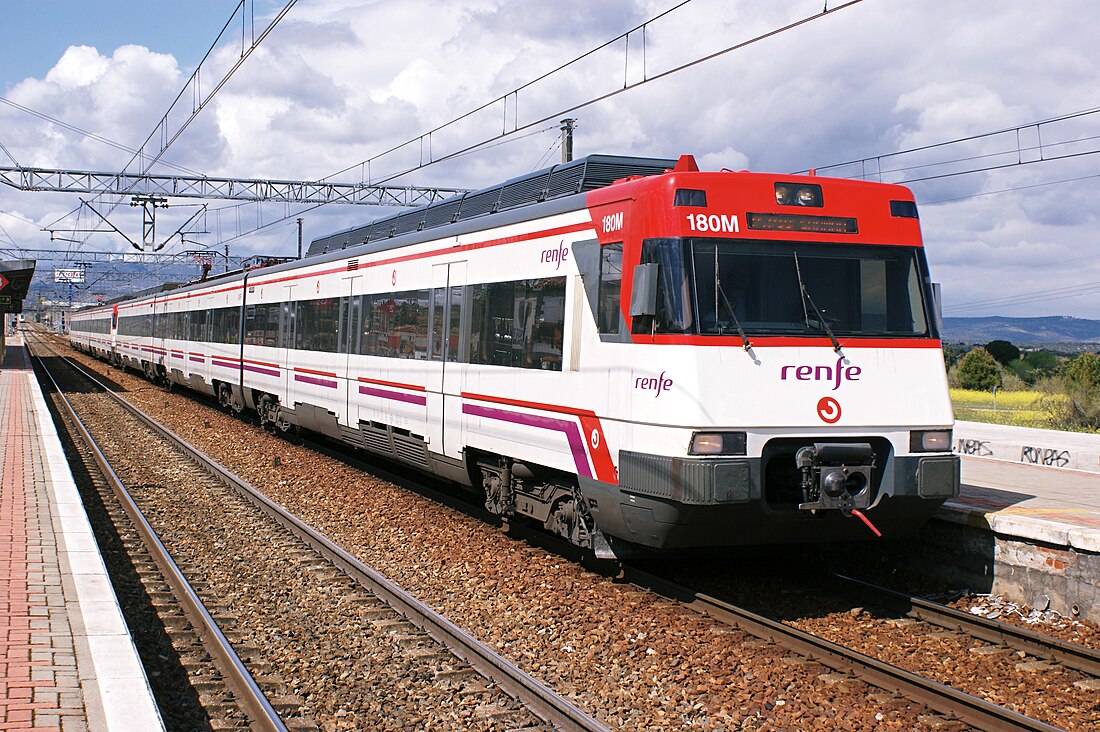Renfe Class 446
Commuter train From Wikipedia, the free encyclopedia
The Renfe Class 446 is a series of electric multiple units designed to provide effective commuter services in major urban centers in Spain.
This article relies largely or entirely on a single source. (October 2019) |
| Renfe Class 446 | |
|---|---|
 Cercanias 446.180 at Pinar de Las Rozas station | |
| Manufacturer | CAF, MACOSA, MTM, Cenemesa, Conelec, Melco |
| Constructed | 1989-1993 |
| Refurbished | 2005 |
| Number built | 170 sets (510 vehicles) |
| Number scrapped | 25 |
| Formation | 3 cars per set |
| Specifications | |
| Train length | 75,993 mm (249 ft 3.9 in) |
| Width | 2,940 mm (9 ft 8 in) |
| Height | 4,185 mm (13 ft 8.8 in) |
| Maximum speed | 100 km/h (62 mph) |
| Traction system | Electric |
| Traction motors | 4 x GEE 326 A2 per motor coach |
| Power output | 2,400 kW or 3,218.5 hp |
| Acceleration | 1 m/s² |
| Electric system(s) | 3000 V DC Catenary |
| Current collector(s) | Pantograph |
| UIC classification | Bo'Bo - 2'2' - Bo'Bo' |
| Safety system(s) | ASFA, some LZB (C-5 Cercanías Madrid) |
| Track gauge | 1,668 mm (5 ft 5+21⁄32 in) (Iberian gauge) |
History
Planning began in the early 1980s and resulted in the prototype Class 445 when commuter services began to assume a major role in cities such as Madrid. The trains then operating these services, mainly Class 440 units, were becoming inadequate to cope with the volume of traffic. It was decided that to provide the required facilities for these service, with their short inter-station distances and high passenger volume, new trains would be needed, with greater acceleration at the cost of maximum speed. Due to the 2004 Madrid train bombings, three trains of this class were decommissioned. Two of the damaged sets were amalgamated to form a new train and the third set was repaired and returned to service.[citation needed]
Design
Summarize
Perspective
Introduced in 1989, the 446 series was an innovative train design by Renfe. Each set having 2,400 kW (3,200 hp) of power, allowing a maximum acceleration of 1 m (3 ft 3 in) /s² with a top speed of 100 km/h (62 mph). The three car sets consist of two driving motor cars and an intermediate trailer, a new concept for Renfe.[1] Each car has three pairs of double doors for quick entry and exit of travelers. One of the major drawbacks of these units, which earned them the nickname dodotis (a type of baby's nappy), is that originally they did not have toilets in the cars.
Outwardly they are of similar appearance to the later Renfe Class 447 design, with which they can operate with some limitations in traction and brake. Recent changes and enhancements included the addition of hustle alarms, both sound and indicator lights, for closing doors. Of the 170 units delivered, 25 have been withdrawn, including those affected by the 2004 Madrid train bombings. The units can be found operating metro type inner suburban services around Madrid, Seville, San Sebastián, Santander and Bilbao where the distances between stations is often 1–2 km (0.62–1.24 mi) or even less.
Formation
Each set is made of 3 cars:
Numbering example
^ The set no.1 is numbered as 001M-001R-002M (UIC numbering: 9-446-001+7-446-001+9-446-002), the second as 003M-002R-004M (9-446-003+7-446-002+9-446-004), and so on (M means powered and R trailer).[2]
References
Wikiwand - on
Seamless Wikipedia browsing. On steroids.
